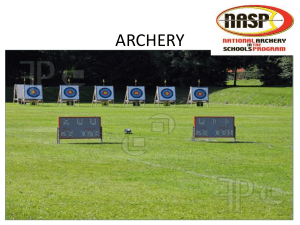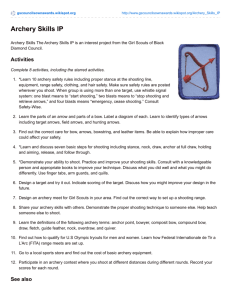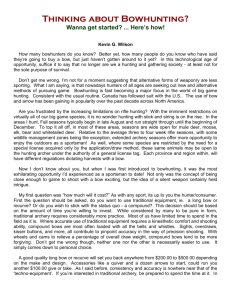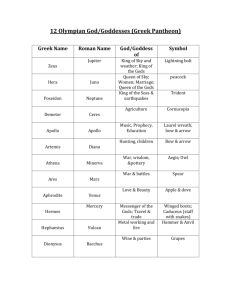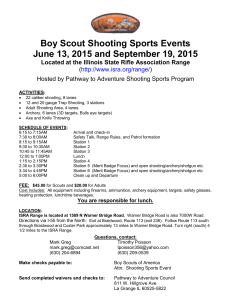File - Havant & Hayling Bowmen
advertisement
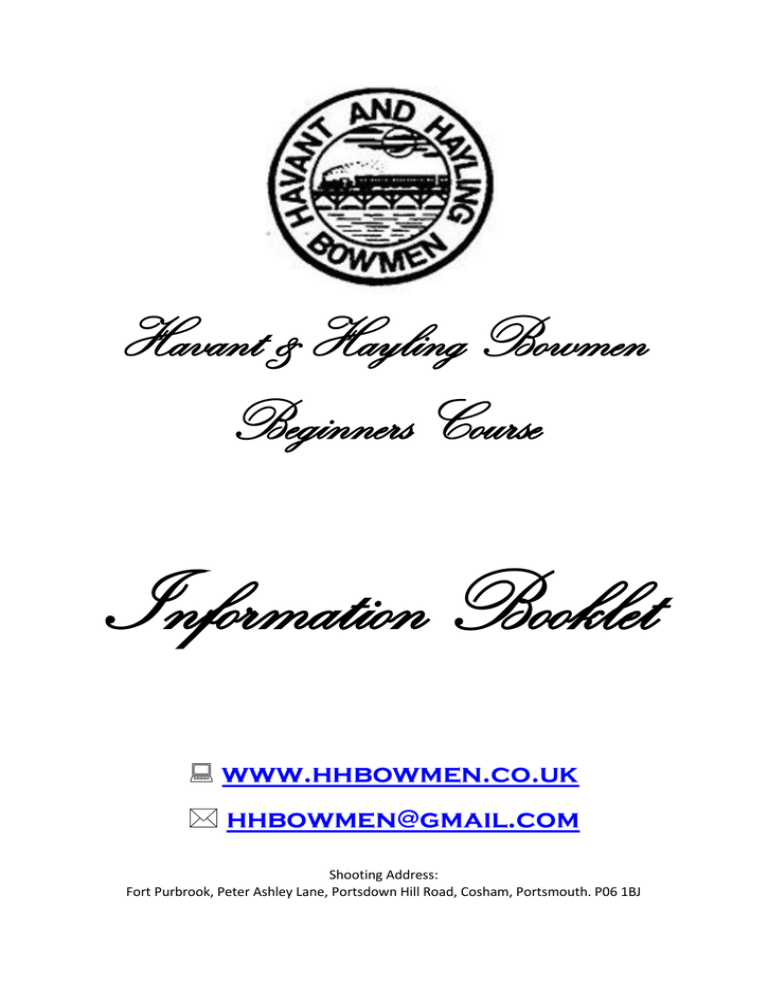
Havant & Hayling Bowmen Beginners Course Information Booklet www.hhbowmen.co.uk hhbowmen@gmail.com Shooting Address: Fort Purbrook, Peter Ashley Lane, Portsdown Hill Road, Cosham, Portsmouth. P06 1BJ 2|Page Hello and Welcome, On behalf of us all at Havant and Hayling Bowmen we hope that you enjoy our beginner’s course and find everyone helpful. This booklet is intended as a backup to all you will encounter on the course and as an account of any basic concepts that you may wish to read at your leisure. Please feel free to ask us if there is anything you would like explained further, or if there is something you would like to know that is not covered in this booklet. We will do our best to answer. We hope you have fun and enjoy this ancient sport as we all do. You will be very welcome to join our club after your beginners' course ends and some information regarding this can be found in the following pages. Good luck and best wishes from us all 3|Page Your Archery Leaders Keith Keeping Brian Thorne Mark Gilbert Les Gibbons Ian Salter David Gerrard Steve Trinder 4|Page Beginners Course - 6 Week Programme In your first lesson you will be introduced to your instructors, learn about equipment, the various parts of the bow and the basic rules of safety. You will learn how to hold and shoot a take down-bow, and how to correctly and safely pull arrows. You will start shooting at 10 yards, then 15 yards, building up to 20 and 30 yards after the first couple of weeks. You will shoot at various types and sizes of target faces whilst you are guided towards perfecting your technique. The emphasis is on lots of practice. Hopefully you will experience the pleasure of getting your arrows in the center of the target and it can be a very satisfying feeling. Don't be disheartened however if your arrows seem to have a mind of their own preferring the grass to the target face (we all suffer from this on occasions). Our archery leaders have been trained to spot the little inconsistencies that can cause this and will help you correct them. We usually end the course with a fun shoot called 'archery darts' which is 'round the clock' on a face similar to a dartboard. Our instructors will be pleased to answer any questions you may have so please ask 5|Page About our Club Our main shooting venue is at Fort Purbrook, which is situated on the top of Portsdown Hill. Thursday evenings in the summer, Wednesday evenings in the winter, and Sunday mornings are our main Club meetings, although we have access to shoot seven days a week all year round. We are a friendly club welcoming all ages and abilities. Unfortunately we do not have provisions for wheelchair bound people. The Club also maintains an active social side with events put on during the year. For further details and a fuller flavour of the club please visit our web site at: www.hhbowmen.co.uk 6|Page Joining a Club When the course is completed, if you want to continue shooting, you will need to obtain insurance through the Grand National Archery Society (GNAS) before you can start shooting. This can be arranged through the club) and is renewable from end September each year. This, together with your certificate, will allow you to apply to join any club convenient to you. Our club membership fees are currently £65 for adults and £30 for juniors (10 - 18 years) and £100 for a couple. These are due in May. A discount of £5 is given against the membership fee to those who have completed the Beginners Course. Please see our Club Secretary or one of the archery leaders for further details. Our members are always willing to help and will try to make you feel at home 7|Page Buying Equipment It is essential that you only purchase equipment that is suitable to your needs and thus it is not advisable to buy anything until after your beginners course has ended. Our archery leaders will help and advise you when it comes to deciding the best equipment to purchase. You may wish to obtain a copy of the sales catalogue from 'Quick’s' who are the local archery stockiest. This will give you an idea of what is available and how much it costs. Safety Rules Safety is of course paramount when taking part in archery and the following is a brief résumé of the main rules that apply. All shooting will be controlled by a Field Captain, who will signal with a whistle. A nocked arrow (an arrow on the bow) must never be pointed in the direction of another person and must only be aimed in the direction of the target. A bow with an arrow nocked is never drawn anywhere else but on the shooting 8|Page line and then only when the Field Captain has given the all clear using the whistle. Only cross the shooting line when the Field Captain gives a signal to do so. If any person or animal is seen within the shooting safety area whilst shooting is in progress, the call 'FAST' is to be shouted by anyone seeing the danger. This call and or a single blast on a whistle means that all shooting must stop immediately and all arrows removed from the bows. Shooting will only re-commence when a further signal is given by the Field Captain. Any archer not actually shooting must keep at least 5 yards behind the shooting line. Spectators must keep at least 10 yards behind the shooting line. When all arrows have been shot and the signal given by the Field Captain, walk towards the target looking for any arrows that may have fallen short. Do not run. No open toed shoes to be worn. This is very important both for safety and protection of archers and arrows. All archers not pulling arrows from the target must stand to the side of the target to avoid risk of being struck by a carelessly drawn arrow. When pulling arrows they must be grasped as close to the target as possible to avoid bending the arrow shaft. 9|Page Etiquette Good etiquette is important in archery and listed below are some of the Rules of etiquette that apply. A good archer: Does not talk in a loud voice whilst others are shooting. Does not talk to another competitor who obviously prefers to be silent . Does not make an exclamation on the shooting line that might disconcert a neighbour in the act of shooting. Does not go behind the target to retrieve his arrows before his score has been recorded. Does not walk up and down the shooting line comparing scores. Does not touch anyone else's equipment without per-mission. Does not leave litter. A Calls his/her scores in groups of three. E.g. '7-7-5' pause '5-53' etc. If he breaks another's arrow through his own carelessness, pays for it in cash on the spot. Thanks the Target Captain after the round for work on his behalf. > Checks there are always at least 2 archers on the shooting line. 10 | P a g e Technical Information The following pages detail the basic technical aspects of archery. The Recurve Bow The picture on the left is a diagram of a recurve bow. This is the sort of bow you will be using on the beginners course and is the same (in principle) as those used by Olympic archers. Another style of bow used for target archery is the compound bow that uses cams to ease the weight of holding the bow at full draw. There are also different varieties of bare bow (bows that have no sight) probably the most popular in this country is the traditional English Longbow (medieval war bow) made famous in the myth of Robin Hood, and shot today by many enthusiastic traditionalists. 11 | P a g e The Arrow The picture below shows a basic diagram of an arrow and names the main parts. Nocking the Arrow With the arrow nock between index and forefinger. Note the use of a tab (shown below) to protect your fingers. 12 | P a g e Correct Form (or Posture) There have been tomes written about correct and incorrect stance, breath control, mental and physical preparation and even studies on human anatomy in pursuit of the perfect shooting style. Therefore, if you wish to study this in detail, we advise a trip to the library. However, the diagram below shows the basic principles of good form. The archer's stance should be a relaxed, 'think tall' approach, where the bow arm, and shoulders and elbow of the drawing arm complete with nocked arrow are virtually in a straight line. The drawing action should be one of transferring the weight of the bow string onto the back muscles, by rolling the drawing arm shoulder, rather than pulling with the ann. It's a tricky concept to master, but our archery leaders are always willing to give advice even when the official beginner’s course has ended. You will also find many of the archers in the club willing to advise through their own experiences. REPEAT R- relax, E– equal weight on feet, P– posture, E– even stance, A– aim, T– try to hit the target. 13 | P a g e Care of Equipment A general inspection before shooting should detect such things as frayed or damaged strings, loose screws and 'sticky points' where rain may have made moveable parts slightly rusty. A good habit to get into is to dry off the bow thoroughly after shooting in the rain and to occasionally put beeswax on the string. A 'tackle' box is a good idea as it can house spare parts that might be needed in an emergency, such as a spare string, screw driver and Allen keys. In archery, the Scouts motto always applies - 'be prepared'. The Bow It is important not to mistreat the bow. Never dry loose (shoot without a nocked arrow) a bow as this can seriously damage the limbs and even break them. Bows are designed to be bent in one direction only with equal stress on each limb, so never lean on the bow as if it were a walking stick when not shooting. The String Perhaps the most overlooked item on a bow, but one of the most essential. Dry loosing damages and can break bow strings. Always replace a frayed or worn string. Arrows Never shoot arrows that are too short for your draw length as this can cause accidents if the arrow falls off the arrow rest. Arrows are quite robust but can be bent easily if miss handled usually when being pulled from the target. Be gentle! 14 | P a g e A Few Archery Terms Anchor Point Bare Bow Boss Bowyer Braced Bow Bracer Clicker Compound Bow Cresting Damper Draw Draw Length End Face Fast A point on the face that becomes a regular reference point to which the string is drawn back. A bow with no sights and limited shooting aids. The object the target archery face is pinned to. Person who makes/repairs archery equipment. A bow that is strung ready to shoot. A lower arm protector for the bow arm. An item positioned on recurve bows that clicks as the arrow pile is pulled past it. A bow that uses a system of pulleys to take the strain At full draw. Coloured marking placed near the fletch of an arrow for identification purposes. A usually small powder or mercury filled weight attached to the bow to absorb the shock of release. The act of pulling a nocked bowstring back prior to Shooting. The correct distance for an individual to draw the bow on each shot. Six arrows shot in succession. In relation to a target, the surface that you shoot at. Warning to STOP shooting. 15 | P a g e Fletch F.I.T.A. Flat Bow Flight shooting GNAS Gold Kisser Limbs Long Bow Long Rod Nock Over-bowed Pile Quiver Recurve Bow The vanes/feathers at the rear of the arrow that aid its aerodynamic flight Federation Internationale de Tir a l'arc The World governing body for all amateur archery. A type of bare bow that has flat limbs A shooting contest where the objective is to shoot the longest distance. Grand National Archery Society Governing body For archery in the UK. The center of the target, scoring 9 points for Imperial rounds and 10 points for metric rounds. A small disc or marking on the string to help gain a consistent anchor point. The two arms of the bow attached to the riser. A bow made from wood to traditional size and design specifications with no sights or shooting Aids. An item added to the bow to help stabilise it. A grooved part of the arrow that attaches to the string. Using a bow that is too strong a poundage for an individual. The pointed tip of the arrow. A device for holding arrows. A bow constructed to have the tip of bias curve towards the back of the bow increasing efficiency. 16 | P a g e Release Riser Round Scope Sight Stabiliser String Tab Tackle Tassel Tournament Weight The point of loosing the arrow from the bow. The handle of a bow. An archery shoot over a predefined distance or Group of distances. Divided between Imperial and Metric distances and different scoring methods There are over 60 types of round that we can shoot. A magnified sight used on compound bows. A device used to help aim. A weighted attachment for the bow that helps Stabilisation The action of preparing the bow for shooting. A device (often made of leather) that protects the Archer’s fingers when shooting Archery equipment A piece of fabric or a pom-pom of wool used to clean Mud from arrow. Essential for longbow archers. A competition. Details can be obtained from the Records and Tournaments Officer. The amount of pull, measured in pounds, required to draw the bow to full draw. 17 | P a g e 5 Zone Scoring 10 Zone Scoring This is the GNAS scoring method for imperial rounds With distance measured in yards. Points are awarded As 9,7,5,3,1 and miss. This is the F.I.T.A. and Olympic scoring method for Metric rounds with distance measured in meters. Points are awarded as 10,9,8,7,6,5,4,3,2,1 and miss. 18 | P a g e Handicaps, Classifications and Scoring Within the UK we use the GNAS handicapping and classification system for all archers. This enables weaker archers to compete in handicapped tournaments alongside highly skilled archers with reasonable; some would say good, chance of beating them. The classification scheme gives an annual assessment of each archers skill by classifying them according to ability as either unclassified, 3rd class, 2nd class or 1st class. Then for the more accomplished archers there are Bowman, Master Bowman and finally Grand Master Bowman classifications. To obtain a classification an archer must complete at least three official Rounds that have been scored according to GNAS rules. Our archery leaders can give full instruction on how to complete score sheets in order to record a round for classification purpose. In conclusion we would like to wish you every enjoyment during our Beginner’s course. Always remember that above all archery is fun, Frustrating at times, but equally satisfying at others. Here at Havant and Hayling Bowmen we like to ensure that everyone enjoys their shooting. Thank you. The Club 19 | P a g e Havant and Hayling Bowmen RISK ASSESSMENT — FORT PURBROOK The following RISK ASSESSMENTS are in addition to G.N.A.S. Safety Rules of Archery. ON ENTERING FORT PURBROOK CARE SHOULD BE TAKEN ON THE FOLLOWING "HAZARDS" STEPS There are many steps in various parts of the Fort that you as Members may come across. These steps can be very slippery when wet and shoes are muddy. Use the hand rails and take care when going up and down the steps. THE TUNNEL The main areas the club shoots are the top field and in the moat. To get there you have to use the tunnel. The walls of the tunnel are very uneven and the floor can be slippery after rain-fall. Take your time and take care. IN THE MOAT Down in the moat we have a family of rabbits who love to dig holes here and there causing hazards if care is not taken when walking up and down the field to collect arrows. Make sure care is taken at all times whilst in the moat. SETTING UP Before any shooting can take place the target area has to be set up. Care should be taken when setting up the stands and bosses -Beware of wood splinters in the stands. The bosses are heavy — take care when lifting them onto stands. 2 people must be used to lift the bosses off the trolley and stands. BE AWARE OF YOUR SURROUNDINGS AT ALL TIMES 20 | P a g e APPLICATION TO JOIN HAVANT AND HAYLING BOWMEN NAME/s _____________________________________________ ADDRESS: _____________________________________________ _____________________________________________ _____________________________________________ _____________________________________________ TELEPHONE NO: ______________________________________ EMAIL ADDRESS: ______________________________________ TYPE OF MEMBERSHIP (Please tick) No. Persons Dates of Birth (Juniors) ADULT JUNIOR COUPLE DATE: ____________ SIGNATURE: _____________________ Please note: If membership is for a junior, an adult with parental responsibility must sign and always be present with them. Please hand this completed form to the club secretary, or to your Course Archery Leader, with the relevant fees. 21 | P a g e
